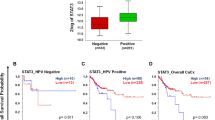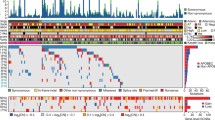Abstract
Cervical cancer (CC) as other cancer types, presents molecular deregulations, such as the alterations of transcription factors. Krüppel-like factors (KLF) are a family of transcriptional regulators. They are involved in diverse cellular processes, such as proliferation, apoptosis, and angiogenesis among others. Here, we analyzed the expression of all 17 KLF members at messenger RNA (mRNA) level, and protein expression of the two most commonly altered KLF5 and KLF6 in cervical tissues. Fifty-nine cervical tissues ranging from normal tissue to CC were evaluated for KLF1–17 mRNA expression by end-point RT-PCR and KLF5 by qRT-PCR. For KLF5 and KLF6 protein analysis, a tissue microarray was constructed containing the 59 cases and subjected for immunohistochemistry assay and KLF6 IVS1-27G>A single nucleotide polymorphism by direct DNA sequencing. KLF2–16 expressions were present in normal tissue, whereas all 17 were present in Low-Grade Squamous Intraepithelial Lesion, High-Grade-SIL and CC, unrelated to presence of human papillomavirus (HPV). KLF5 mRNA expression gradually increased throughout the subgroups and overexpressed in CC (p = 0.01). KLF5 and KLF6 proteins were immunodetected in all samples. For the KLF6 SNP analysis, 80 % of the CC population analyzed presented GG genotype and the remaining 20 % presented GA genotype (p = 0.491). Our present data show that KLFs expression could not be related to HPV presence, at least at transcriptional level, and KLF5 mRNA overexpression could represent a potential molecular marker for CC; KLF6 SNP has no relation to increased risk of CC.




Similar content being viewed by others
References
Woodman C, Collins S, Young L. The natural history of cervical HPV infection: unresolved issues. Nat Rev Cancer. 2007;7:11–22.
Bosch F, Lorincz A, Munoz N, Meijer C, Shah K. The causal relation between human papillomavirus and cervical cancer. J Clin Pathol. 2002;55:244–65.
Nerbert D. Transcription factors and cancer: an overview. Toxicology. 2002;182:131–41.
Bureau C, Hanoun N, Torrisani J, Vinel J, Buscail L, Cordelier P. Expression and function of Kruppel Like-Factors (KLF) in carcinogenesis. Curr Genomics. 2009;5:353–60.
Cao Z, Sun X, Icli B, Wara A, Feinberg M. Role of Kruppel-like factors in leukocyte development, function, and disease. Blood. 2010;22:4404–14.
Lahiri K, Zhao J. Krüppel-like factor 8 emerges as an important regulator of cancer. Am J Transl Res. 2012;3:357–63.
Tetreault M, Yang Y, Katz J. Krüppel-like factors in cancer. Nat Rev Cancer. 2013;13:701–13.
Husman A, Walboomers J, van den Brule A, Meijer C, Snijders P. The use of general primers GP5 and GP6 elongated at their 3' ends with adjacent highly conserved sequences improves human papillomavirus detection by PCR. J Gen Virol. 1995;76:1057–62.
Livak K, Schmittgen T. Analysis of relative gene expression data using real-time quantitative PCR and the 2deltaCT method. Methods. 2001;25:402–8.
Narla G, DiFeo A, Reeves H, Friedman S, Martignetti J. A Germline DNA polymorphism enhances alternative splicing of the KLF6 tumor suppressor gene and is associated with increased prostate cancer risk. Cancer Res. 2005;4:1213–22.
Bachtiary B, Boutros P, Pintilie M, Shi W, Bastianutto C, Li J, et al. Gene expression profiling in cervical cancer: an exploration of intratumor heterogeneity. Clin Cancer Res. 2006;19:5632–40.
Pyeon D, Newton M, Lambert P, den Boon J, Sengupta S, Marsit C, et al. Fundamental differences in cell cycle deregulation in human papillomavirus–positive and human papillomavirus–negative head/neck and cervical cancers. Cancer Res. 2007;10:4605–19.
Zhai Y, Kuick R, Nan B, Ota I, Weiss S, Trimble C, et al. Gene expression analysis of preinvasive and invasive cervical squamous cell carcinomas identifies HOXC10 as a key mediator of invasion. Cancer Res. 2007;21:10163–72.
Suzuki T, Aizawa K, Matsumura T, Nagai R. Vascular implications of the Kruppel-like family of transcription factors. Arterioscler Thromb Vasc Biol. 2005;25:1135–41.
Bourillot P, Savatier P. Krüppel-like transcription factors and control of pluripotency. BMC Biol. 2010;8:125.
Yien Y, Bieker J. EKLF/KLF1, a tissue-restricted integrator of transcriptional control, chromatin remodeling, and lineage determination. Mol Cell Biol. 2013;33:4–13.
McConnell B, Yang V. Mammalian Krüppel-like factors in health and diseases. Physiol Rev. 2010;90:1337–81.
Eaton S, Funnell A, Sue N, Nicholas H, Pearson R, Crossley M. A Network of Kruppel-like Factors (KLFs) KLF8 is repressed by KLF3 and activated by KLF1 In vivo. J Biol Chem. 2008;283:26937–47.
Taniguchi H, Jacinto F, Villanueva A, Fernandez A, Yamamoto H, Carmona F, et al. Silencing of Kruppel-like factor 2 by the histone methyltransferase EZH2 in human cancer. Oncogene. 2012;31:1988–94.
Lyng H, Brovig R, Svendsrud D, Holm R, Kaalhus O, Knutstad K, et al. Gene expressions and copy numbers associated with metastatic phenotypes of uterine cervical cancer. BMC Genomics. 2006;7:268.
Liu S, Zheng P. High aldehyde dehydrogenase activity identifies cancer stem cells in human cervical cancer. Oncotarget. 2013;4:2462–75.
Dong J, Chen C. Essential role of KLF5 transcription factor in cell proliferation and differentiation and its implications for human diseases. Cell Mol Life Sci. 2009;66:2691–706.
McConnell B, Bialkowska A, Nandan M, Ghaleb A, Gordon F, Yang V. Haploinsufficiency of Kruppel-Like Factor 5 rescues the tumor-initiating effect of the ApcMin mutation in the Intestine. Cancer Res. 2009;6:4125–33.
Kwak M, Lee H, Hur K, Park D, Lee H, Kim W, et al. Expression of Krüppel-like factor 5 in human gastric carcinomas. J Cancer Res Clin Oncol. 2008;134:163–7.
Zheng H, Zhou Z, Huang J, Chaudhury L, Dong J, Chen C. Kruppel-like factor 5 promotes breast cell proliferation partially through upregulating the transcription of fibroblast growth factor binding protein 1. Oncogene. 2009;28:3702–13.
Conesa P, Domenech A, Orantes F, Ortiz S, Sahuquillo L, Acosta J, et al. Effect of human papillomavirus on cell cycle-related proteins p16, Ki-67, Cyclin D1, p53, and ProEx C in precursor lesions of cervical carcinoma. Am J Clin Pathol. 2009;132:378–90.
Branca M, Giorgi C, Santini D, Di Bonito L, Ciotti M, Costa S, et al. Survivin as a marker of cervical intraepithelial neoplasia and high-risk human papillomavirus and a predictor of virus clearance and prognosis in cervical cancer. Am J Clin Pathol. 2005;124:113–21.
Soon M, Hsu L, Chen C, Chu P, Liou J, Lin S, et al. Expression of Kruppel-like factor 5 in gastric cancer and its clinical correlation in Taiwan. Virchows Arch. 2011;459:161–6.
Tong D, Czerwenka K, Heinze G, Ryffel M, Schuster E, Witt A, et al. Expression of KLF5 is a prognostic factor for disease-free survival and overall survival in patients with breast cancer. Clin Cancer Res. 2006;12:2442–8.
Difeo A, Martignetti J, Goutham N. The role of KLF6 and its splice variants in cancer therapy. Drug Resist Updat. 2009;12:1–7.
Andreoli V, Gehrau R, Bocco J. Biology of Kruppel-Like Factor 6 transcriptional regulator in cell life and death. IUBMB Life. 2010;62:896–905.
Gehrau R, Astolfo D, Dumur C, Bocco J, Korischoner N. Nuclear expression of KLF6 tumor suppressor factor is highly associated with overexpression of ERBB2 oncoprotein in ductal Breast carcinomas. PLoS ONE. 2010;5:e8929.
Kajimura D, Dragomir C, Ramirez F, Laub F. Identification of genes regulated by transcription factor KLF7 in differentiating olfactory sensory neurons. Gene. 2007;388:34–42.
Simmen F, Su Y, Xiao R, Zeng Z, Simmen R. The Krüppel-like factor 9 (KLF9) network in HEC-1-A endometrial carcinoma cells suggests the carcinogenic potential of dys-regulated KLF9 expression. Reprod Biol Endocrinol. 2008;6:41–52.
Faryna M, Konermann C, Aulmann S, Bermejo J, Brugger M, Diederichs S, et al. Genome-wide methylation screen in low-grade breast cancer identifies novel epigenetically altered genes as potential biomarkers for tumor diagnosis. FASEB J. 2012;26:4937–50.
Fernandez-Zapico M, Mladek A, Ellenrieder V, Folch-Puy E, Miller L, Urrutia R. An mSin3A interaction domain links the transcriptional activity of KLF11 with its role in growth regulation. EMBO J. 2003;22:4748–58.
Nakamura Y, Migita T, Hosoda F, Okada N, Gotoh M, Arai Y, et al. Krüppel-like factor 12 plays a significant role in poorly differentiated gastric cancer progression. Int J Cancer. 2009;125:1859–67.
Henson B, Gollin S. Overexpression of KLF13 and FGFR3 in oral cancer cells. Cytogenet Genome Res. 2010;128:192–8.
Yamamoto J, Ikeda Y, Iguchi H, Fujino T, Tanaka T, Asaba H, et al. A Kruppel-like factor KLF15 contributes fasting-induced transcriptional activation of mitochondrial acetyl-CoA synthetase gene AceCS2. J Biol Chem. 2004;279:16954–62.
Helbing T, Volkmar F, Goebel U, Heinke J, Diehl P, Pahl H, et al. Kruppel-like factor 15 regulates BMPER in endothelial cells. Cardiovasc Res. 2010;85:551–9.
Lomberk G, Mathison A, Grzenda A, Seo S, DeMars C, Rizvi S, et al. Sequence-specific recruitment of heterochromatin protein 1 via interaction with Krüppel-like Factor 11, a human transcription factor involved in tumor suppression and metabolic diseases. J Biol Chem. 2012;287:13026–39.
Daftary G, Lomberk G, Buttar N, Allen T, Grzenda A, Zhang J, et al. Detailed structural-functional analysis of the Kruppel-like Factor 16 (KLF16) transcription factor reveals novel mechanisms for silencing Sp/KLF sites involved in metabolism and endocrinology. J Biol Chem. 2012;287:7010–25.
Dong P, Kaneuchi M, Xiong Y, Cao L, Cai M, Liu X, et al. Identification of KLF17 as a novel epithelial to mesenchymal transition inducer via direct activation of TWIST1 in endometrioid endometrial cancer. Carcinogenesis. 2014;35:760–8.
Fujiu K, Manabe I, Ishihara A, Oishi Y, Iwata H, Nishimura G, et al. Synthetic retinoid Am80 suppresses smooth muscle phenotypic modulation and in-stent neointima formation by inhibiting KLF5. Circ Res. 2005;97:1132–41.
Bialkowska A, Crisp M, Bannister T, He Y, Chowdury S, Schurer S, et al. Identification of small-molecule inhibitors of the colorectal cancer oncogene Kruppel-like factor 5 expression by ultrahigh-throughput screening. Mol Cancer Ther. 2011;10:2043–51.
Acknowledgments
We would like to thank Universidad Autónoma de Ciudad Juárez for partial support. During this work, the authors DMR, KTP, PRM, MMR and MRE were recipients of a Consejo Nacional de Ciencia y Tecnologia fellowship. This work was a partial fulfillment by DMR for Ph. D. degree at UACJ.
Funding
This work was partially supported by grant 202222 from Fondos Sectoriales Consejo Nacional de Ciencia y Tecnologia-Mexico.
Conflicts of interest
The authors declare that they have no conflict of interest.
Author’s approval
All authors have approved the final version of this manuscript.
Author information
Authors and Affiliations
Corresponding author
Electronic supplementary material
Below is the link to the electronic supplementary material.
ESM 1
(PDF 58 kb)
Rights and permissions
About this article
Cite this article
Marrero-Rodríguez, D., Taniguchi-Ponciano, K., Jimenez-Vega, F. et al. Krüppel-like factor 5 as potential molecular marker in cervical cancer and the KLF family profile expression. Tumor Biol. 35, 11399–11407 (2014). https://doi.org/10.1007/s13277-014-2380-4
Received:
Accepted:
Published:
Issue Date:
DOI: https://doi.org/10.1007/s13277-014-2380-4




